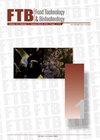优化细菌纳米纤维素的生产工艺:对生长和生物活性化合物的影响
IF 2.5
4区 农林科学
Q3 BIOTECHNOLOGY & APPLIED MICROBIOLOGY
引用次数: 0
摘要
研究背景。近年来,关于细菌纤维素生产的研究领域发展迅速,在医疗和食品工业等各种应用领域具有潜在的用途。以前的研究主要集中在通过各种方法优化生产过程,例如使用不同的碳源和操纵环境条件。然而,仍需要进一步的研究来优化生产工艺并了解细菌纤维素合成的潜在机制。实验方法。我们使用Plackett-Burman和Box-Behnken实验设计来分析影响细菌纤维素生产的各种因素。对优化后的培养基进行了发酵动力学分析,并对所产纤维素进行了表征。之所以使用这种方法,是因为它允许识别影响细菌纤维素生长的重要因素,培养基的优化,以及所产生的纤维素的表征。结果和结论。结果表明,较高的蔗糖浓度、较高的康普茶水平、较低的细菌共生培养量和酵母大小是提高细菌纤维素产量的最显著因素,而其他因素对细菌纤维素产量无显著影响。优化后的培养基中总酚类化合物和总黄酮含量显著提高,抗氧化活性也相应提高。制备的纯细菌纤维素除结晶度高、热稳定性好外,还具有较高的吸水能力。创新和科学贡献。该研究通过优化培养基,使细菌纤维素的生产效率更高,具有重要的科学贡献。该优化培养基可用于生产含有高含量生物活性化合物的红茶菌型饮料和生产具有高结晶度和热稳定性的细菌纤维素。此外,该研究还强调了细菌纤维素作为一种高度吸水材料在包装和生物医学工程等领域的应用潜力。本文章由计算机程序翻译,如有差异,请以英文原文为准。
Optimizing the Production Process of Bacterial Nanocellulose: Impact on Growth and Bioactive Compounds
Research background. The field of research on bacterial cellulose production has been growing rapidly in recent years, with the potential for its use in various applications, such as in the medical and food industries. Previous studies have focused on optimizing the production process through various methods, such as using different carbon sources and manipulating environmental conditions. However, further research is still needed to optimise the production process and understand the underlying mechanisms of bacterial cellulose synthesis. Experimental approach. We have used Plackett-Burman and Box-Behnken experimental designs to analyse various factors impact on bacterial cellulose production. The optimized medium was analysed for fermentation kinetics, and the cellulose produced was characterised. This approach was used because it allows for the identification of significant factors impacting bacterial cellulose growth, the optimisation of the culture medium, and the characterisation of the produced cellulose. Results and conclusions. The results indicated that higher sucrose concentrations, higher kombucha levels, and lower symbiotic culture of bacteria and yeast size were the most significant factors for improving bacterial cellulose production, while the others had no relevant impact. The optimized medium showed an increase in the concentration of total phenolic compounds and total flavonoids, as well as relevant levels of antioxidant activity. The pure bacterial cellulose produced showed high water absorption capacity, in addition to high crystallinity and thermal stability. Novelty and scientific contribution. The study makes a significant scientific contribution by optimizing the culture medium to produce bacterial cellulose in a more productive and efficient way. The optimized medium can be used for producing a kombucha-type drink containing a high content of bioactive compounds and the production of bacterial cellulose with high crystallinity and thermal stability. Additionally, the study highlights the potential of bacterial cellulose as a highly water-absorbing material with applications in areas such as packaging and biomedical engineering.
求助全文
通过发布文献求助,成功后即可免费获取论文全文。
去求助
来源期刊

Food Technology and Biotechnology
工程技术-生物工程与应用微生物
CiteScore
3.70
自引率
0.00%
发文量
33
审稿时长
12 months
期刊介绍:
Food Technology and Biotechnology (FTB) is a diamond open access, peer-reviewed international quarterly scientific journal that publishes papers covering a wide range of topics, including molecular biology, genetic engineering, biochemistry, microbiology, biochemical engineering and biotechnological processing, food science, analysis of food ingredients and final products, food processing and technology, oenology and waste treatment.
The Journal is published by the University of Zagreb, Faculty of Food Technology and Biotechnology, Croatia. It is an official journal of Croatian Society of Biotechnology and Slovenian Microbiological Society, financed by the Croatian Ministry of Science and Education, and supported by the Croatian Academy of Sciences and Arts.
 求助内容:
求助内容: 应助结果提醒方式:
应助结果提醒方式:


